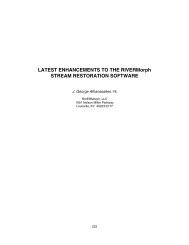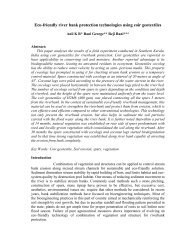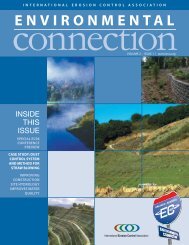ENVIRONMENTAL - International Erosion Control Association
ENVIRONMENTAL - International Erosion Control Association
ENVIRONMENTAL - International Erosion Control Association
Create successful ePaper yourself
Turn your PDF publications into a flip-book with our unique Google optimized e-Paper software.
PEER<br />
review<br />
Research Briefs<br />
Improving Soil Conditions and<br />
Cover Tends to Reduce <strong>Erosion</strong><br />
The purpose of this column is to provide knowledge to readers of Environmental Connection by summarizing the latest<br />
results of relevant research. The sources are mostly refereed science and engineering journals, which means the information<br />
has been reviewed by other scientists and engineers before it was published.<br />
This process doesn’t ensure that the data reported is entirely accurate or reflects typical conditions, but it gives us some<br />
confidence that the study was performed and the analysis stated in a reasonable manner. It always is up to the reader<br />
to interpret the results relative to his or her experience. Papers from conference proceedings, which usually are not peer<br />
reviewed, may occasionally be included if the results are deemed reasonable and timely.<br />
This review cannot cover all papers published in all journals, but hopefully the ones we include will be helpful to the<br />
reader. For more details, the reader is encouraged to look up the referenced articles.<br />
By Rich McLaughlin, PhD<br />
Wood Strands as Effective as Straw<br />
Wood strands, one of the newer erosion control products, have been the subject of<br />
several studies recently. One study was conducted under laboratory conditions using a<br />
flume and artificial rainfall, and found that the strands worked as well as straw in reducing<br />
erosion by 98 percent [3] . More recently, this was confirmed in two different soils,<br />
although the wood strands had some advantage in a finer textured-soil [10] .<br />
This has been updated with a field study comparing strands to straw and shredded<br />
wood in two Idaho forest areas similar to post-fire conditions [4] . The wood strands applied<br />
at 48 percent cover had about the same reduction in erosion as the straw applied at<br />
67 percent cover—about 80 percent compared to bare soil. The shredded wood, applied<br />
at 50 percent cover, only reduced erosion by 41 percent, but that was still a significant<br />
reduction. The vegetation coverage, however, was best on the bare soil plots, although it<br />
had a maximum of only 7 percent. The main difference in the ground cover treatments<br />
was that the wood strands stayed intact during the year-long investigation, while the<br />
straw and shredded wood lost 29–36 percent of their ground coverage. This may be<br />
important in dry areas where vegetation establishment takes many years.<br />
Using Topsoil and Compost to Repair Disturbed Areas<br />
Establishment of vegetation in disturbed areas in semi-arid Mediterranean climates<br />
can be a challenge. One approach that was found to be successful was to spread stockpiled<br />
topsoil from a nearby area [9] . This material not only improved soil properties, but<br />
it already contained a seed bank of local plants that already were adapted to the area.<br />
The additional treatment of hydroseeding with either local or “standard” seed mixes<br />
improved vegetation cover further, but in the end the local plants dominated. The investigators<br />
suggested that the amendments in the hydroseeding mix (wood fiber, fertilizer,<br />
humic acid) enhanced the topsoil treatment. It is not clear that the “local” plants were<br />
necessarily “native,” so it is important not to interpret that term. Kudzu is local in the<br />
Southeast United States, but few would consider it native. The depth of topsoil was not<br />
provided in the article, only that it had been stockpiled for less than three months and<br />
that it came from a nearby vineyard.<br />
OCTOBER 2007 • 9













